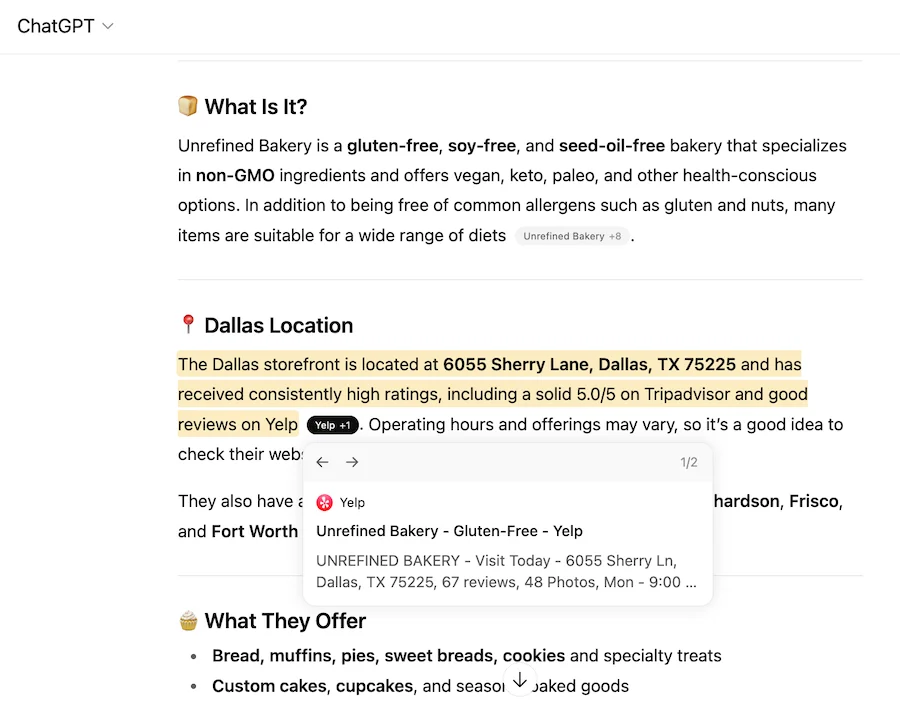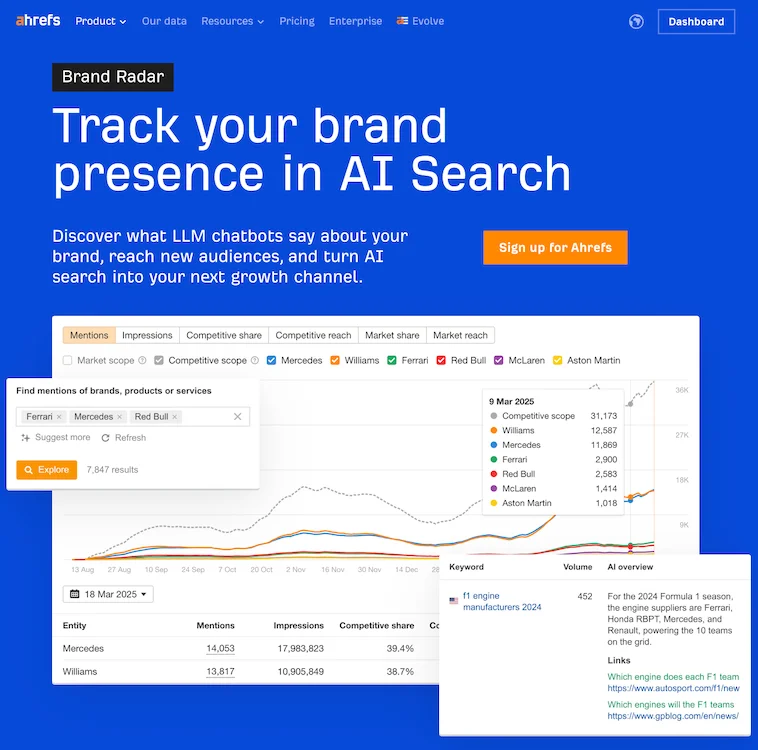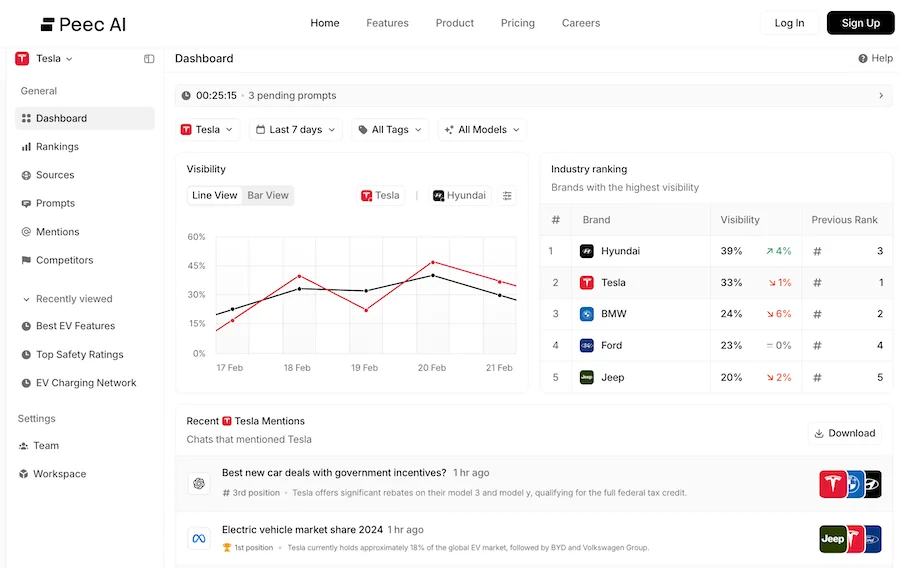People aren’t just using ChatGPT, Claude, Gemini, or Perplexity for specific prompts anymore. These tools are gradually replacing traditional search engines for everyday questions, product comparisons, and decision-making, and that shift is changing how brands get discovered.
ChatGPT alone now handles around 37.5 million search-like queries per day. While it’s still far behind Google’s 14 billion queries, usage is growing fast. And with that growth comes a new layer of brand exposure, one that businesses can’t see through web analytics or search rankings alone.
If your business gets mentioned in an AI-generated answer, it might not include a link. It might not even be accurate. These models pull from all kinds of sources, blend them together, and present the result as fact.
That’s why it’s important to know how your brand is showing up in these tools.
In this guide, we’ll explain why that matters, what to look for in a tracking tool, and compare the best options for monitoring your presence in LLM answers.
Contents
- Why tracking LLM mentions matters
- How to integrate LLM monitoring into your brand strategy
- What to look for in an LLM tracking tool
- The best tools to track LLM mentions
Why tracking LLM mentions matters
Understanding how LLMs talk about your brand is about more than curiosity. It’s about control, context, and competitive edge.
- Reputation management: AI models can synthesize incorrect or outdated information about your brand. If left unchecked, these inaccuracies can damage customer trust. As The New York Times reports, AI “hallucinations” are becoming harder to spot and more harmful when they involve real companies.
- Strategic messaging: The way LLMs describe your brand reveals how your positioning is being interpreted across the web. If they consistently use certain phrases or tones, that’s a valuable signal, helping you refine your messaging across websites, ads, product pages, and social channels.
It’s helpful to know how LLMs are describing your business to potential searchers.
- Competitive benchmarking: Tracking how often and how positively competitors appear in AI responses gives you a new way to evaluate their visibility, influence, and perceived strengths, insights that traditional SEO tools won’t uncover.
- Emerging channel visibility: Like SEO a decade ago, LLM visibility is a rising channel. Getting ahead now gives you a first-mover advantage in a space that will only grow in importance.
This all ties into a new discipline: Generative Engine Optimization (GEO). While traditional SEO is about ranking in search results, GEO is about being the answer. And that starts with knowing when and how you’re showing up.
 Need help understanding the new rules for SEO? Download our free guide >> How to Do SEO Right—Right Now!
Need help understanding the new rules for SEO? Download our free guide >> How to Do SEO Right—Right Now!
How to integrate LLM monitoring into your brand strategy
LLM mention tracking becomes powerful when you use it to drive actual decisions. Here are a few ways it can help you:
- SEO: If a keyword is consistently triggering answers that exclude you, that’s a signal to improve coverage, depth, or authority.
- PR and comms: If AI is misquoting or misunderstanding your brand, it’s time to create clearer narratives or issue corrections in public channels.
- Support: Incorrect support responses in AI can reflect outdated docs. Use tracking insights to guide your knowledge base updates.

In this case, the address shown is correct. But if it wasn’t, you could see it’s pulled from Yelp and make a change there.
- Product: LLMs misunderstanding your features? Product marketing can use that feedback to rework how features are described in documentation and launch materials.
 Want to use AI the right way? Get tips, tools, prompts, and tricks in this free download >> Emergency Guide to AI in Marketing
Want to use AI the right way? Get tips, tools, prompts, and tricks in this free download >> Emergency Guide to AI in Marketing
What to look for in an LLM tracking tool
Most tools in this space are still evolving. When assessing them, focus on features that help you monitor mentions in a way that drives action:
- Model coverage: Can it monitor multiple AI engines (ChatGPT, Claude, Gemini, Perplexity, etc.)?
- Prompt + response pairing: Does the tool show you both the user prompt and the AI’s answer?
- Context awareness: Does it offer sentiment analysis or tone classification to help interpret how your brand is being portrayed?
- Syndication monitoring: Can it detect when an AI-generated answer gets reused in blog posts, summaries, or newsletters?
- Integrations: Does it play well with your existing analytics, PR monitoring, or marketing dashboards?
The best LLM tracking tools: A detailed breakdown
Now, let’s walk through the top tools available today with a level of detail that helps you make an informed decision.
1. Ahrefs’ Brand Radar
What it is:
Ahrefs’ Brand Radar is an experimental feature that the company recently introduced to its well-established SEO monitoring suite. It builds on Ahrefs’ core strengths (crawling, indexing, and backlink analysis) and introduces a new layer: monitoring how AI models like ChatGPT and Claude potentially reference or surface your brand in their outputs.

Thousands of SEO professionals worldwide already trust Ahrefs, and Brand Radar is their early response to the growing influence of generative AI. While not a standalone LLM-specific tool, it offers LLM-aware functionality for businesses already using Ahrefs for SEO and content monitoring.
Key features:
- LLM snippet detection: Surfaces instances where AI-generated summaries (especially those indexed or reposted) mention or paraphrase your brand.
- Multi-source mention monitoring: Aggregates mentions across AI-generated content, social media, online forums, news publications, and blogs.
- Proprietary web crawler: Leverages Ahrefs’ industry-leading crawl infrastructure to capture content where AI answers have been shared or quoted.
- Brand alerts + dashboards: Sends notifications when new mentions (including suspected LLM-derived ones) are detected.
Strengths:
- Seamless SEO integration: If you’re already tracking backlinks, keywords, and content gaps with Ahrefs, Brand Radar adds another dimension without extra overhead.
- Data enrichment: Unlike other tools that treat brand mentions in isolation, Ahrefs provides SEO context—e.g., whether an AI mention comes from a high-authority source, is driving backlinks, or affects keyword visibility.
- Trusted interface: Many marketing and SEO teams are already familiar with Ahrefs’ UI, making onboarding easier.
Limitations:
- Lacks real-time LLM integration: Brand Radar doesn’t monitor live ChatGPT or Claude sessions. Instead, it detects AI mentions that appear in republished content indexed by Ahrefs (e.g., Medium posts, Reddit discussions, newsletters quoting ChatGPT).
- Prompt-response blind spots: You won’t see the original user prompt or the AI’s full response unless that content was published somewhere publicly and indexed.
- Not standalone: You must already be a paying Ahrefs customer, and Brand Radar is currently available in beta to select plans. Unfortunately, Ahrefs charges $150/month per LLM, so you’ll need to budget $600/month to track everything, which is often a bit much for small businesses.
Best for:
SEO teams and content marketers who already rely on Ahrefs for link tracking and keyword monitoring, and who want to understand how AI-generated content might be piggybacking off their brand equity. It’s especially useful for identifying whether AI-driven summaries are distorting, amplifying, or paraphrasing your key messaging across the web.
2. Peec AI
What it is:
Peec AI is a dedicated LLM visibility platform built to track how your brand is showing up inside responses generated by tools like ChatGPT, Claude, Gemini, and Perplexity. It focuses on surfacing actual prompt–response activity rather than monitoring secondary reposts, giving you a direct line into how these models interpret, mention, and contextualize your brand.

Key features:
- Prompt–response mapping: Logs and archives both user prompts and the corresponding answers where your brand appears, giving you valuable insight into how LLMs understand your positioning.
- Multi-model coverage: Supports tracking across OpenAI, Anthropic, Google, and Perplexity—four of the most commonly used LLMs in commercial and consumer environments.
- Sentiment and frequency analysis: Categorizes brand mentions as positive, neutral, or negative, and lets you trend those over time.
- Custom alerting: Real-time alerts when new mentions occur, with filters for brand/product terms, categories, or competitor overlap.
Strengths:
- Peec provides actual LLM response logs, not just scraped summaries or derivative mentions. That means you’re getting closer to the truth of how AI sees and talks about your brand.
- Its multi-model support ensures you’re not just optimizing for one platform.
- It’s excellent for identifying low-frequency brand queries or long-tail prompts that wouldn’t show up in traditional SEO tools.
- The platform’s dashboards are built for clarity, offering brand and comms teams actionable insights rather than raw data.
Limitations:
- Historical data is only fully available on enterprise plans, which may be cost-prohibitive for startups or small teams.
- The UI is still maturing; exporting reports and filtering across prompts/answers can be clunky without customization.
- It lacks deep integration with SEO suites or PR monitoring tools, which might create workflow silos unless you pair it with a broader analytics stack.
Best for:
Brand, communications, and product marketing teams who need to understand how LLMs represent them, especially during a launch, media cycle, or moments of reputational sensitivity. It’s also useful for legal and trust teams that want to track misinformation or policy violations.
3. Profound
What it is:
Profound is a brand accuracy and compliance tool built to help businesses monitor how generative AI models, customer support bots, and internal search systems talk about their products, services, and policies. It doesn’t chase SEO metrics or traffic volume. Instead, it gives brands visibility into factual consistency and messaging alignment.
![]()
Key features:
- Knowledge base integration: Syncs with support platforms like Zendesk, Intercom, Notion, and Confluence to analyze how LLMs interpret your owned content.
- AI drift detection: Tracks when generative model outputs start deviating from your official product documentation or brand language.
- Weekly accuracy reports: Provides summaries of LLM answers that reference your brand, with flags for inconsistencies or policy gaps.
- Audit trail and versioning: Creates searchable logs that compliance teams can use to track how misinformation or outdated facts evolve over time.
Strengths:
- Critical for high-stakes messaging environments like fintech, healthcare, and cybersecurity, where inaccurate LLM outputs can lead to legal, ethical, or regulatory issues.
- Pinpoints documentation blind spots by showing which parts of your help center or product pages are being misinterpreted or ignored by LLMs.
- Valuable for product marketing and support alignment, ensuring that what you say internally matches what generative tools deliver externally.
Limitations:
- Not designed for SEO, brand awareness, or marketing analysis. Teams focused on visibility or lead gen will find limited value here.
- Complex setup for smaller orgs. Requires access to and configuration of your internal documentation repositories, which may demand engineering support.
- Limited UI flexibility. Most dashboards prioritize accuracy and auditability over visualization or storytelling.
Best for:
Product marketers, customer success leaders, legal teams, and compliance officers who need to enforce consistency in how LLMs present their brand or product stack. If you’re in a regulated industry or run a complex SaaS product, Profound helps ensure your LLM presence stays aligned, factual, and on-message.
4. Keyword.com’s AI Visibility Tracker
What it is:
Keyword.com’s AI Visibility Tracker bridges traditional keyword rank tracking with AI monitoring. It extends its existing SEO infrastructure to help businesses see how generative AI platforms (like ChatGPT and Claude) use or reference their content when answering commercial and informational queries.
![]()
Key features:
- Keyword-driven mentions: Input keywords and track when your brand appears in generative answers to those queries.
- SERP + AI overlay: Compare organic ranking performance with AI visibility to see where you’re winning or losing exposure.
- Frequency reporting: Monitor how often your brand shows up across AI summaries for tracked terms.
- Custom tags: Group and analyze mentions by product, campaign, or business unit.
Strengths:
- A great on-ramp to GEO for teams already invested in traditional SEO.
- Clear visualization of overlap or disconnect between organic results and AI-generated answers.
- Simple onboarding for SEO pros familiar with keyword tracking tools like Semrush or Ahrefs.
Limitations:
- No visibility into prompts or full AI output, so the tool is best for tracking trends rather than understanding nuance.
- Not diagnostic, so you won’t know why you’re being excluded from an answer, only that it happened.
- Limited multi-model coverage at the time of writing; primarily optimized for ChatGPT.
Best for:
SEO and content teams looking to understand how their keyword landscape is shifting in an AI-first world. Great for benchmarking generative exposure alongside organic SERP performance.
5. XFunnel
What it is:
XFunnel is a cross-channel marketing analytics platform that added LLM visibility to help marketers measure and compare brand presence across web, search, social, and AI-generated content. It brings generative visibility into a broader attribution and measurement context.
![]()
Key features:
- Cross-channel dashboards: View your LLM, search, and social media mentions in a single place.
- AI sentiment aggregation: See how brand mentions trend sentiment-wise across major AI tools.
- Attribution tracking: Identify whether specific campaigns are increasing generative mentions.
- Competitor comparison: Evaluate how your brand stacks up against rivals in LLM presence.
 Want an even deeper look at what your competitors are doing? Free guide >> How to Spy on Your Competitors: 7 Ways to Become a Competitive Supersleuth
Want an even deeper look at what your competitors are doing? Free guide >> How to Spy on Your Competitors: 7 Ways to Become a Competitive Supersleuth
Strengths:
- One of the most comprehensive marketing visibility dashboards available—great for high-level strategy planning.
- Saves time and platform-switching by combining AI, social, and SEO insights into one view.
- Great for agencies juggling multiple clients or properties.
Limitations:
- LLM visibility is surface-level, so you won’t see full prompts or detailed response data.
- Sentiment analysis can skew inaccurate without human validation, especially in nuanced industries.
- Limited flexibility in parsing AI-specific signals compared to dedicated GEO tools.
Best for:
CMOs, brand leads, and agency teams who need an executive-level dashboard for tracking marketing performance across traditional and AI-first channels. Best suited for a top-down strategy rather than tactical prompt optimization.
6. First Answer
What it is:
First Answer is a truth-first LLM monitoring solution focused on content accuracy and factual alignment. Its core value is ensuring that what AI models say about your company is correct, current, and consistent with your internal knowledge.

Key features:
- Factual accuracy scoring: Evaluates generative responses against your product specs, knowledge base, or source-of-truth documentation.
- Version drift detection: Alerts you when AI-generated answers change significantly over time.
- Structured data comparison: Supports direct mapping to internal knowledge graphs or CMS documentation.
- Factual consistency dashboards: Tracks how frequently models describe your brand correctly versus incorrectly.
Strengths:
- Laser-focused on brand accuracy, which is critical for technical products, policy-heavy brands, or regulated industries.
- Great for product marketers, technical content leads, and legal teams who need to verify how products and features are described in the AI wild.
- Supports repeat testing to track how models improve or degrade over time.
Limitations:
- Only tracks factual queries: It’s not a general brand mention tracker. If you’re not being directly referenced in user prompts, it won’t surface you.
- Requires solid documentation to be useful: You need structured, high-quality internal data to compare against.
Best for:
Tech companies, B2B SaaS providers, and any business where LLM misinformation could harm conversion, support accuracy, or regulatory standing. It’s a must-have for teams focused on documentation fidelity, product marketing precision, and brand trustworthiness.
Are LLM mentions the new backlinks?
For years, SEO revolved around backlinks: who was linking to you, why, and how often. Today, the next frontier is LLM visibility.
Being mentioned (accurately, favorably, and consistently) in generative model outputs is quickly becoming a signal of authority and credibility. These mentions shape how people understand your brand, even if they never land on your website.
Start now. Pick one or two tools. Monitor how your brand is being portrayed. And use those insights to shape your next content strategy, positioning doc, or product release. The future of search won’t wait.
The post 6 LLM Tracking Tools to Monitor AI Mentions (+Why It’s Crucial!) appeared first on WordStream.